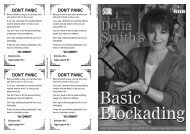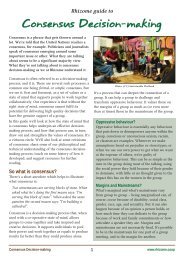Visual Auditory & Tactile Learners - Rhizome
Visual Auditory & Tactile Learners - Rhizome
Visual Auditory & Tactile Learners - Rhizome
You also want an ePaper? Increase the reach of your titles
YUMPU automatically turns print PDFs into web optimized ePapers that Google loves.
<strong>Rhizome</strong> guide to<strong>Visual</strong> <strong>Auditory</strong> & <strong>Tactile</strong> <strong>Learners</strong>There are many different theories of learning styles. A learning style isthe way an individual interacts with learning, accesses it, or processesthe learning they are engaged with. If the methods of a trainer orteacher don't accommodate the learning styles of their learners thensome people may not be able to learn effectively.One of the simplest, and most useful, theories is that of <strong>Visual</strong>, <strong>Auditory</strong>and <strong>Tactile</strong> (or Kinaesthetic) learners. These can be seen as 3 doorwaysthrough which learning can enter the brain. The right stimulation opensthe doors and learning can take place. A lack of stimulation can ensurethe doors stay firmly shut limiting, or preventing, learning.<strong>Visual</strong> learners learn best when they arereceiving visual stimulation, whether it'scolour, graphics, photos or video, or justengaging facial expressions and bodylanguage. <strong>Visual</strong> learners can often be spotted in a groupas they are most likely to doodle. Rather than this being asign of lack of concentration, in the visual learner it is away of stimulating their brain to learn. They may also takenotes as this turns spoken words into a written (i.e visual)form.<strong>Auditory</strong> learners learn best through sound.That could be background music, or aninteresting tone of voice for example. <strong>Auditory</strong>learners may well say (or at least mouth) wordsto themselves – a mechanism that helps them tohear the sound of the written word.
<strong>Tactile</strong> learners learn through movement,from getting 'hands on' with theirlearning. This doesn't necessarily meanexperiential learning, although it may be.It just requires some physical movement– so activities that involve moving whilstthinking, such as spectrum lines or rovingideastorms, are enough. <strong>Tactile</strong> learnersmay create their own movement if none is provided –whether tapping their toes or their pen on the desk.Of course no one individual is a pure <strong>Visual</strong>, <strong>Auditory</strong> or <strong>Tactile</strong> learner.We are all a mix and many of us can learn through a wide variety ofmeans even if they don't best suit our learning styles. But some of usdo have strong preferences, and for those people a lack of the rightstimulation can be a serious obstacle to learningImplications for our trainingWhenever we are training a group we will have a mix of these 3learning styles present. That places a responsibility on us to ensure thatwe use a variety of different methods in our training sessions. It can beas simple as supporting spoken information with a visual aid, of using aspectrum line instead of a seated discussion, or of including regularphysical games. If we get it wrong we prevent our trainees learning, butif we get it right we increase the learning that's taking placeLearning styles also help us to put problem behaviour in workshopsinto perspective. Suddenly a person behaving in a disruptive way, whowe might normally write off as an “awkward customer”, might now beseen as a learner not having their needs met. Perhaps the group hasbeen sat for over an hour with nothing but auditory and visualstimulation. The <strong>Tactile</strong> learner has good reason to be getting restless,frustrated or bored. Once we realise this we can solve the problemthrough prior planning, or a quick change of activity in the moment.rhizome@rhizome.coop0845 458 4776This work is licensed under CreativeCommons Attribution Sharealike2.0:UKlicense. Seerhizome.coop/resources for details





